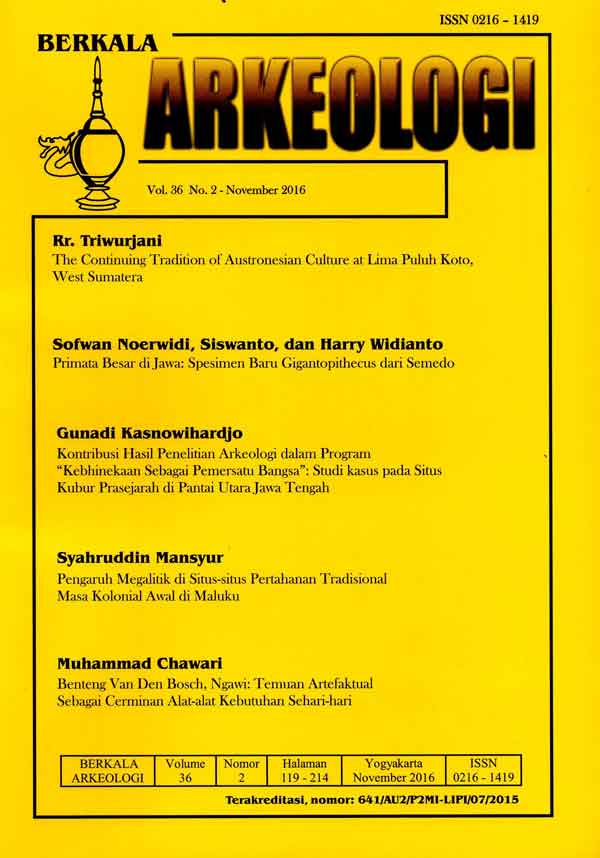PRIMATA BESAR DI JAWA: SPESIMEN BARU GIGANTOPITHECUS DARI SEMEDO
Main Article Content
Abstract
In 2014 there was found two "enigmatic" specimens of mandible, which named as Semedo 3417 and 3418. Both mandibles are morphologically similar but twice bigger than common primate’s jaw. In this research, we use morphology and morphometric analysis to determine the species identity and taxonomic position of those specimens. For comparison study we use some samples from Homo erectus (Java and China), Gigantopithecus (blacki and bilaspurensis), Australopithecines (robust and gracile). Based on morphology and morphometric characters on the mandible and teeth, it is concluded that Semedo specimen tends to be close to Gigantopithecus blacki. The discoveries of Gigantopithecus fossil in Java has implication on some research problem, especially regarding the adaptation pattern of this species which known only found at high latitudes environment. Furthermore this discovery has reinforced the perspective that tropical environment has a very high biodiversity, particularly on primate fossils.
Article Details

This work is licensed under a Creative Commons Attribution-NonCommercial-ShareAlike 4.0 International License.
References
Bulbeck, D dan S. O’Connor. 2011. “The Watinglo mandible: A second terminal Pleistocene Homo sapiens fossil from tropical Sahul with a test on existing models for the human settlement of the regionâ€, HOMO - Journal of Comparative Human Biology 62. pp. 1–29
Frayer, David W. 1975. “Gigantopithecus and its relationship to Australopithecusâ€, American Journal of Physical Anthropology 39/3, pp. 413–426
Grehan, J.R. dan J.H. Schwartz. 2009. “Evolution of the Second Orangutan: Phylogeny and Biogeography of Hominid Originsâ€, Journal of Biogeography 36, pp. 1823–1844
Howell, F. C. 1969. “Remains of Hominidae from Pliocene/Pleistocene formations in the lower Omo basin, Ethopiaâ€, Nature 223, pp. 1234-1239.
Kaifu, Y. 1997. “Changes in Mandibular Morphology from the Jomon to Modern Periods in Eastern Japanâ€, American Journal of Physical Anthropology 104. pp. 227–243
Larsen, C. S. dan Phillip L. Walker. 2010. "Bioarchaeology: Health, Lifestyle, and Society in Recent Human Evolution", in Clark Spencer Larsen ed., A Companion to Biological Anthropology. Singapore: Blackwell Publishing. pp. 379-394.
Marcus, L. F. 1990. “Chapter 4.Traditional morphometricsâ€, dalam F. J. Rohlf and F. L. Bookstein. (eds) Proceedings of the Michigan Morphometric Workshop, Special Publication No. 2, Ann Arbor MI: The University of Michigan Museum of Zoology, pp. 77–122.
Martin R, dan Saller K. 1957. Lehrbuch der Antropologie. Stuttgart: Gustav Fischer Verlag.
Martin R.D. 1990. Primate Origins and Evolution: A phylogenetic reconstruction, New Jersey: Princeton University Press.
Morant, G.M., 1923. “A first study of the Tibetan skullâ€.Biometrika 14, pp. 193–260.
Nail, K. 1998. “The mysterious phylogeny of gigantopithecusâ€, Lambda Alpha Journal, Vol. 28, pp. 28-36.
Noerwidi, S. dan Siswanto. 2014. “Alat Batu Situs Semedo: Keragaman Tipology dan Distribusi Spasialnyaâ€, Berkala Arkeologi Vol.34 No.1, Yogyakarta: Balai Arkeologi Yogyakarta
Pilbeam, D. 1970. “Gigantopithecus and the origins of Hominidaeâ€, Nature 225, pp. 516-519.
Pope, G.G. dan E. Delson. 2000. “Gigantopithecusâ€, dalam E. Delson, I. Tatersal, J.A. van Couvering, A.S. Brooks (eds): Encyclopedia of Human Evolution and Prehistory, 2nd edition, New York: Garlan, pp. 288-289.
Simons, E.L. dan S.R.K Chopra. 1969. “Gigantopithecus (Pongidae, Hominoidea): a New Species from North Indiaâ€. Postilla (138), pp. 1-18.
Siswanto.2013. “Penelitian Manusia, Budaya, dan Lingkungan pada Kala Plestosen di Situs Semedo, Kabupaten Tegal, Jawa Tengahâ€, Laporan Penelitian Arkeologi, Yogyakarta: Balai Arkeologi
Siswanto.2014. “Penelitian Manusia, Budaya, dan Lingkungan pada Kala Plestosen di Situs Semedo, Kabupaten Tegal, Jawa Tengahâ€, Laporan Penelitian Arkeologi, Yogyakarta: Balai Arkeologi
Siswanto dan Noerwidi, Sofwan. 2014. “Fosil Proboscidea dari Situs Semedo: Hubungannya dengan Biostratigrafi dan Kehadiran Manusia di Jawaâ€, Berkala Arkeologi Vol.34 No.2, Yogyakarta: Balai Arkeologi Yogyakarta
Slice Dennis E. 2005. “Modern Morphometricsâ€, in Dennis E. Slice (ed.), Modern morphometrics in physical anthropology, New York: Kluwer Accademic / Plenum Publishers, pp. 1-46.
Robinson, Jt dan Steudel, K. 1973. “Multivariate discriminant analysis of dental bearing on early hominid affmitiesâ€, Journal of Human Evolution 2, pp. 509-527.
von Koenigswald, G.H.R. 1935. “Eine fossile saogetierfauna mit Simia aus Sudchinaâ€, Proc. K. Akad Wetensch, 38, Amsterdam, pp. 872-879.
__________. 1952. “Gigantopithecus blacki von Koenigswald, a giant fossil hominoid from the Pleistocene of Southern Chinaâ€, Anthro. Papers of Am. Mus. of Natl. Hist., 43, pp. 291-325.
__________. 1983. “The Significance of Hitherto Undescribed Miocene Hominoids fonn the Siwaliks of Pakistan in the Senckenberg Museum, Frankfurtâ€, dalam RL Ciochon dan RS Corruceini (eds): New Interpretations of Ape and Human Ancestry, New York: Plenum Press, pp.539-557.
Weidenreich, F. 1945. “Giant early man from Java and south Chinaâ€, Anthro. Papers of Am. Mus. of Natl. Hist., 40, pp. 1-134.
__________. 1946. Apes, Giants, and Man. University of Chicago Press, Chicago
White, T.D., dan Folkens, P.A. 2005. The Human Bone Manual.London: Elsevier Academic Press.
Widianto, H. 1993. “Unité et diversité des hominidés fossiles de Java: Présentation de Restes Humains Fossiles Inéditsâ€, Thése du Docteural, Paris: MNHN.
__________. 2011. Nafas Sangiran, Nafas SItus-situs Hominid, Sragen: BPSMP Sangiran
Widianto, H., M. Hidayat. 2006. “Semedo, Situs Baru Kehidupan Manusia Purba pada Kala Plestosenâ€, Berita Penelitian Arkeologi No. 21, Yogyakarta: Balai Arkeologi
Widiyanta, W., M. Hidayat. 2012. â€Penelitian Homo erectus SItus Semedo: Umur, Budaya dan Lingkunganâ€, Laporan Eksplorasi, Sragen: BPSMP Sangiran

